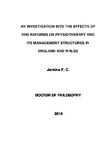AN INVESTIGATION INTO THE EFFECTS OF NHS REFORMS ON PHYSIOTHERAPY AND ITS MANAGEMENT STRUCTURES IN ENGLAND AND WALES
| dc.contributor.supervisor | Sheaff, Rod | |
| dc.contributor.author | Jenkins, Fiona | |
| dc.contributor.other | Faculty of Arts, Humanities and Business | en_US |
| dc.date.accessioned | 2016-08-18T13:30:22Z | |
| dc.date.available | 2016-08-18T13:30:22Z | |
| dc.date.issued | 2016 | |
| dc.identifier | 10221762 | en_US |
| dc.identifier.uri | http://hdl.handle.net/10026.1/5334 | |
| dc.description.abstract |
Background. A constantly changing reform agenda has frequently changed NHS management arrangements. Impacts are documented for medicine and nursing but much less so for the third largest profession, physiotherapy. Aims. To evaluate the impact of NHS reforms on physiotherapy analysing whether the resulting management structures impacted on staff and patient care; comparing English and Welsh arrangements with previous periods. Method. Observational mixed methods including a narrative literature review; questionnaire census; semi-structured interviews; physiotherapy narrative history; and a normative evaluation of physiotherapy management structures. Results. NHS reforms had impacted on the structure of physiotherapy management and organisation. Of the eight management structures described in Øvretveit’s (1992) schema: Three were not observed; two were observed but needed modification; three were observed and empirically applicable with small modifications; social enterprises had evolved with management structures similar to those in the NHS. The main changes to physiotherapy managers’ roles between1989-2014 were substantial reorganisations affecting the employing organisation and role of the managers with a reduction in Community Trusts and the introduction of competing providers into English NHS physiotherapy. Clinical autonomy had been extended with advanced practice roles in some areas. The role of the professional body and TU (the CSP) was generally well-regarded by managers. The differences between England and Wales related more to management structures than national policy differences. Conclusions. Most physiotherapists were managed within cross-AHP structures. Devolved structures were increasingly emerging but physiotherapy managers preferred professionally-led structures. Physiotherapy managers ranked the AHP Directorate the highest and the Fragmented structure the lowest. The AHP professions will need to consider merging to conserve their power as professions and to maximise their combined contribution to patient care and organise to meet fiscal challenges in both countries. | en_US |
| dc.description.sponsorship | Cardiff and University health Board | en_US |
| dc.language.iso | en | en_US |
| dc.publisher | Plymouth University | en_US |
| dc.subject | Management | en_US |
| dc.subject | Organisation | |
| dc.subject | Physiotherapy | |
| dc.subject | NHS | |
| dc.subject | Structures | |
| dc.subject | Allied Health Professions | |
| dc.subject | England | |
| dc.subject | Wales | |
| dc.title | AN INVESTIGATION INTO THE EFFECTS OF NHS REFORMS ON PHYSIOTHERAPY AND ITS MANAGEMENT STRUCTURES IN ENGLAND AND WALES | en_US |
| dc.type | Thesis | |
| plymouth.version | Edited version | en_US |
| dc.identifier.doi | http://dx.doi.org/10.24382/3711 |
Files in this item
This item appears in the following Collection(s)
-
01 Research Theses Main Collection
Research Theses Main


